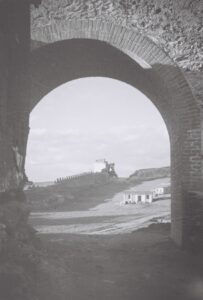The Acropolis of Thessaloniki
City
Migration Period
City Narratives
Category
Full Description
The Acropolis area has remained sparsely populated throughout the history of Thessaloniki. The area’s major landmarks have always been the large wall gates (‘πορτάρες’, pronounced ‘portares’), the Tower of Trigonio or Chain Tower, and the Eptapyrgio or Yedi Kule, the fortress at the highest point of the Acropolis on the north-eastern end of the walls. The buildings of Eptapyrgio date back to several different construction phases, from the Byzantium (mostly the Palaiologos dynasty era) to the Ottoman rule and the 20th century. The conversion of the fortress into a prison in 1890 and the prison’s operation until 1989 further transformed the citadel as more buildings and auxiliary structures were added. Most importantly, though, it rendered the name of this building complex synonymous with the cruelty of the Greek penal system.
Thousands of criminal and political prisoners were imprisoned in Yedi Kule under inhumane conditions, while the area surrounding the compound, which previously had been occupied by a scattering of Muslim cemeteries, functioned as an execution site, especially during the civil war period. For years, the surrounding neighbourhood was tainted by its mere proximity to Yedi Kule and the prison’s unsavoury reputation negatively affected the entire area.
After the Muslim exodus in 1924, several plots of land in the area were auctioned off as exchangeable properties. At the same time, refugees from Asia Minor and the Pontus, along with Roma families, settled in the area. However, the area still remained sparsely built, especially when compared to the rest of Ano Poli. In 1933, the authorities approved a new zoning plan for the area which also recorded all existing development, showing few houses among numerous empty land plots, as is also depicted in the photographs provided here, dating from that same year. The situation remained roughly the same during the Second World War. Many of the houses built during this time were illegally erected abutting the city walls and using them as part of the building structure. Hence, the houses became known as ‘καστρόπληκτα’ (pronounced ‘kastroplikta’ which means ‘castle-stricken’, ‘threatened by the walls’).
Only after the war, when several internal migrants started settling in the area, did local housing construction increase. The Agioi Anargiroi church square, which had been built in the place of a pre-existing mosque called the Popara Baba Mosque, was considered the centre of the area.
Bibliography
For more on Eptapyrgio, see the work of the Eptapyrgio Oral History Group.
http://oralhistorygroups.gr/opi-ept/
Follow the link for a video about an exhibition organised by the group.
https://www.youtube.com/watch?v=b4BI8F0xofo&ab_channel=OpiEptapyrgiou
